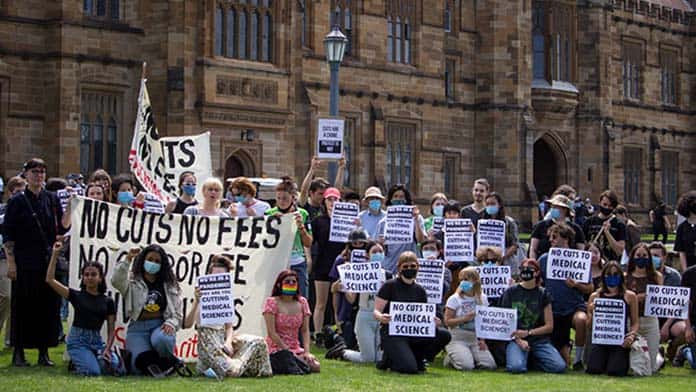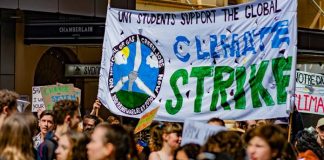Cuts are raining down in universities across the country. Scott Morrison has managed to pass his Fee Hike Bill.
NSW Police have been breaking up attempts to protest these attacks, using the pretext of COVID-19 health orders.
But students at Sydney Uni have shown that it is possible to fight. Hundreds have mobilised repeatedly in the face of police repression. Students have walked out of classes, invaded the Vice-Chancellor’s building, petitioned, passed motions and protested. Courses, jobs and hours have been won back.
Around 200 students and staff assembled for a “teach-in” protest and march against cuts and fees on 14 October. The protest came the day after the National Tertiary Education Union (NTEU) NSW Division held a staff protest of 60 people in Victoria Park, defeating a police attempt to stop the rally in the Supreme Court.
The police repression of the student protest has provoked a major public backlash. Law Professor Simon Rice was arrested, had his legs kicked out from under him and was pushed to the ground by police, despite not even being part of the rally. A number of students were also fined and brutally manhandled.
This has pushed the NSW government to relax protest guidelines, so that rallies of up to 500 people are now permitted.
The protest drew attention to students and staff who have been organising in Medical Science against massive cuts outlined in a “Draft Change Proposal”. The cuts in individual departments and faculties must continue to be a key part of the campaign.
Oscar Chaffey, a student in the department, told the protest, “You’d think that amid a global pandemic the people who are trying to understand how diseases work would be some of the most important jobs to protect—but not according to Dean of the Faculty of Medicine and Health who has passed down brutal staff cuts. The School of Medical Sciences is actually going to fire the entire pathology and physiology departments and make them re-apply for half of the jobs that will be left. They are cutting pharmacology, the field that makes new drugs.
“I was talking to an academic who helps run the course that gives dentistry students clinical foundations so that they can do their placements in hospitals. Out of the seven staff who co-ordinate this course with dental degrees, five of them are about to lose their jobs.
“I may be one of the last students to graduate at this university studying physiology. I simply can’t accept that.”
Over 220 have signed a petition, dozens have participated in a photo petition against the cuts and Medical Science staff and students have mobilised for protests.
There are also looming cuts to student learning support which will hit international students particularly hard. Many students already face wait times of six weeks or two months when they try to book an appointment for assistance with their essays.
Building broader support
Mobilising hundreds has been a real achievement given the crackdown on the right to protest and the reduced numbers of students on campus. For the initial 16 September rally around 25 classes passed motions supporting the strike and hundreds signed a petition against the cuts. This took hour upon hour of conversations, stalls, contacting and lecture bashing to achieve.
Almost 120 students voted to strike in a student assembly in the lead-up. Two classes voted to move so they could join the action, and another six adopted a position of “no penalty” for groups of students and individuals who left class to participate.
Another strength was the organisation of department and faculty contingents. These established organisation beyond the existing left and connected the protests to issues in individual departments. The law students’ contingent grew from five on 16 September to 19 on 23 September. Medical Science students and staff have mobilised, drawing attention to the cuts they are facing. Philosophy, Linguistics, Government and IR, History, Art History, Architecture, Political Economy and others have also mobilised.
But it is a real challenge to build bigger, more disruptive and politically sharp actions. The 2012 job cuts campaign at Sydney Uni had rallies up to 1500 strong, and last year the climate strikes saw over 90 motions passed in lectures and 2200 join the September protest. This is significantly larger than the cuts campaign so far.
Resistance can deliver. In late September Executives at the Conservatorium of Music decided to cut the Jazz Course by 33 hours. This was reversed after a petition and collective pressure from students. The win followed a series of small protests and meetings about cuts at the Con in semester one.
In 2012 half of the academic jobs under threat at Sydney Uni were stopped by mass marches, occupations, student strikes and blockades. Every small fight creates sparks of resistance that can spread.
By Adam Adelpour






